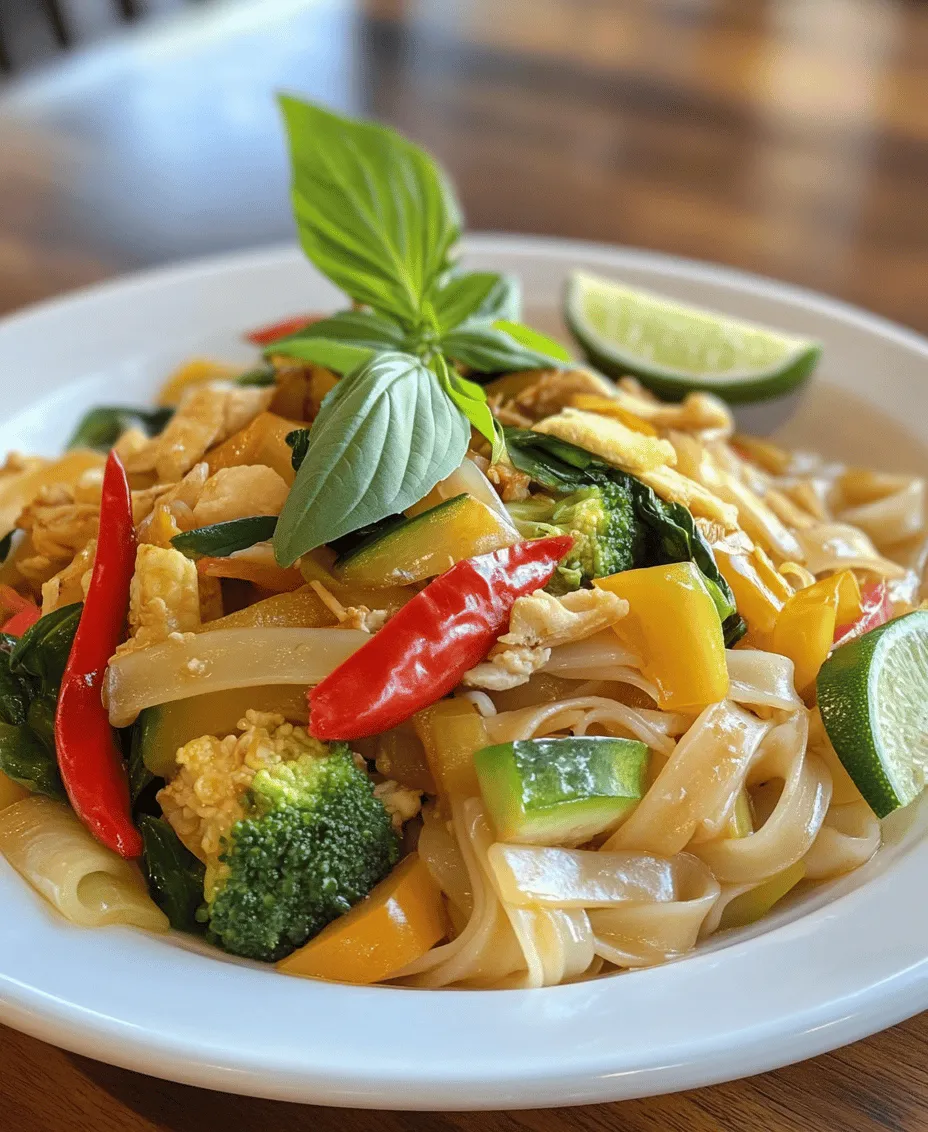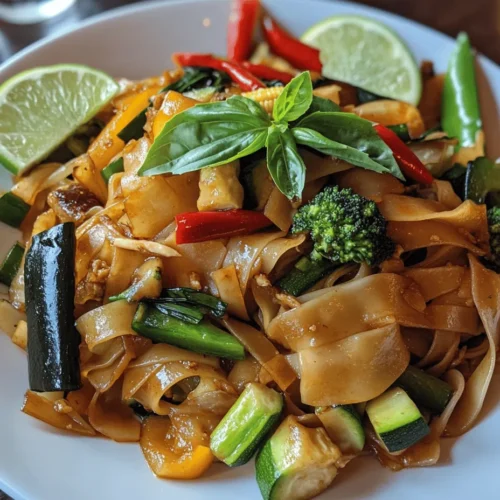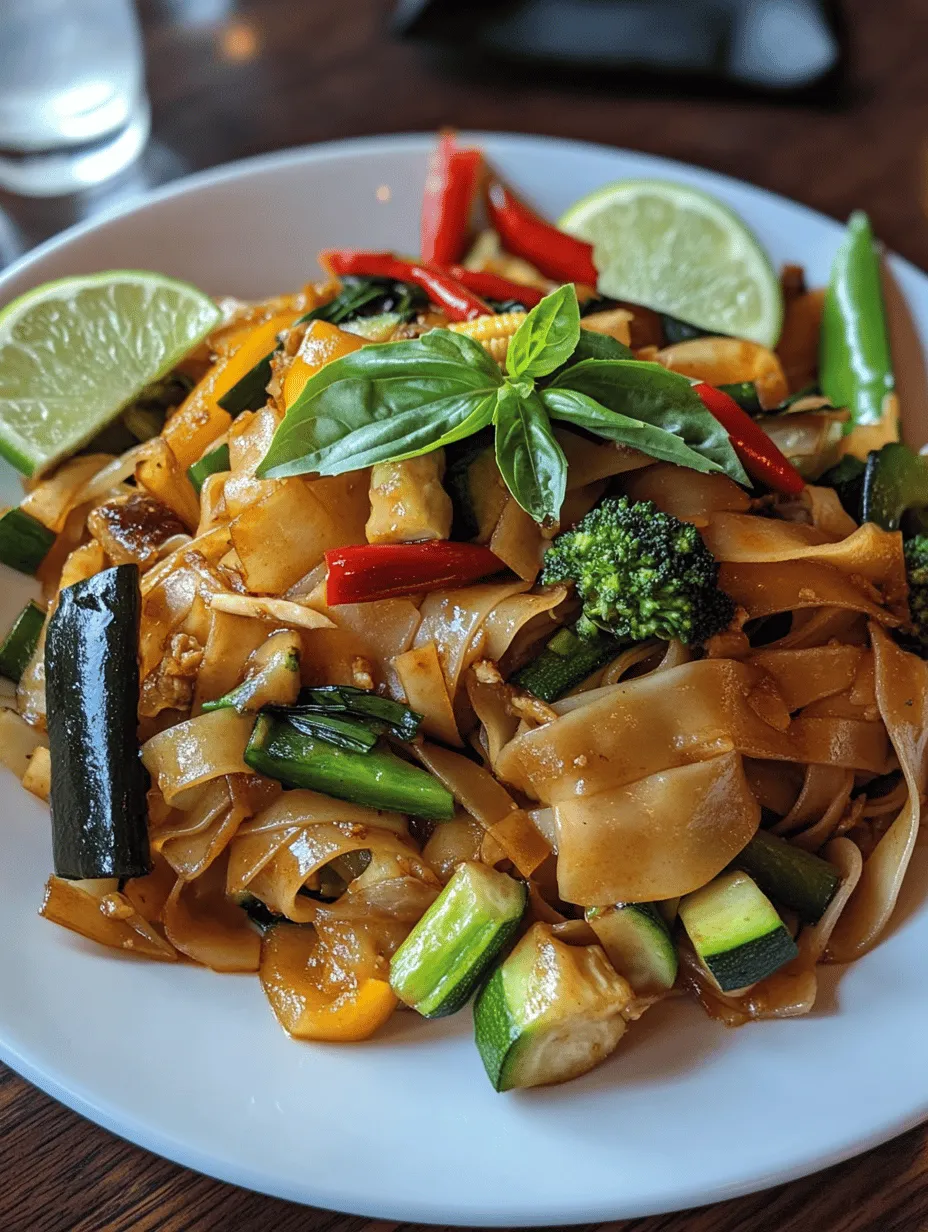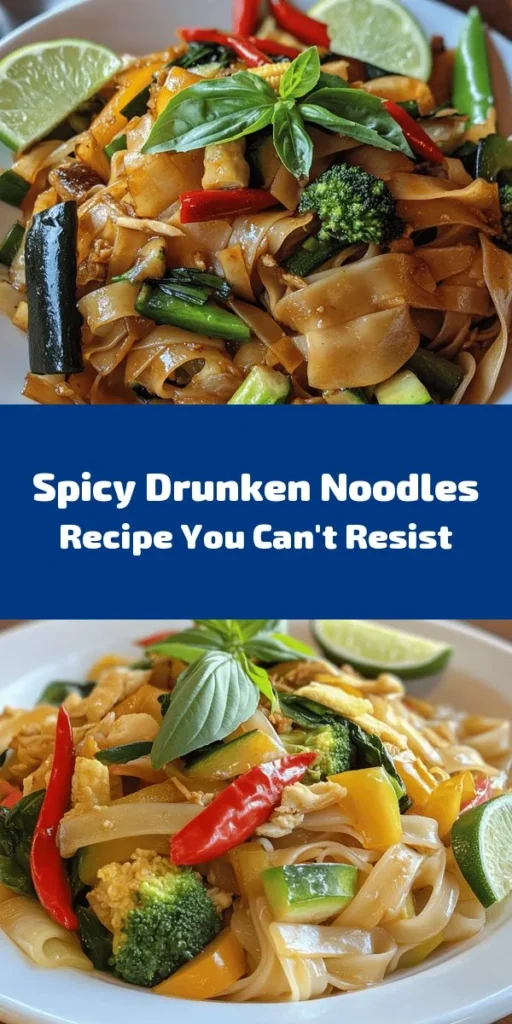Introduction
If you’re a fan of vibrant flavors and hearty meals, then Drunken Noodles, also known as Pad Kee Mao, is a dish that will surely tickle your taste buds. This popular Thai street food is not only a culinary delight but also a dish steeped in cultural significance, making it a staple in many Thai households and restaurants. The name “Drunken Noodles” evokes curiosity; some might wonder if the dish is meant to be enjoyed after a night of revelry, while others might speculate about its spirited ingredients. In truth, the origins of the name are as complex as the flavors within the dish, hinting at the intriguing blend of taste and tradition that defines this beloved meal.
Drunken Noodles are celebrated for their perfect balance of flavors—sweet, salty, spicy, and tangy—all coming together in a harmonious medley. The chewy wide rice noodles soaked in a rich sauce, combined with fresh vegetables and aromatic herbs, create a symphony of textures and tastes. This dish is not only a feast for the palate but also a visual delight, with its colorful ingredients promising a satisfying dining experience. If you’re ready to embark on this culinary journey, let’s dive deeper into the origins and preparation of Drunken Noodles.
Understanding Drunken Noodles
Definition and Origin
Drunken Noodles, or Pad Kee Mao, is a stir-fried noodle dish that has its roots in Thailand. The dish is said to have originated in the 1950s and quickly became popular due to its robust flavors and quick cooking time, making it a favorite among street food vendors. Traditionally served late at night, it is thought to be a remedy for those who may have indulged a bit too much the night before, hence the playful name. However, the exact story behind the name varies, with some attributing it to the fact that it pairs exceptionally well with a cold beer.
Traditional Ingredients and Regional Variations
While the core of Drunken Noodles remains consistent, variations do exist across different regions of Thailand. The primary ingredients include wide rice noodles, fresh vegetables, and a selection of sauces that contribute to its unique flavor profile. Some regions might incorporate additional proteins like chicken, beef, or tofu, while others may focus on a veggie-centric approach.
The dish is known for its use of Thai basil, a critical component that elevates the flavors with its distinct aroma and hint of spice. This herb not only adds depth to the dish but also reflects the freshness that is characteristic of Thai cuisine.
The Role of Thai Basil
Thai basil is more than just a garnish; it is an essential ingredient that provides an aromatic kick to Drunken Noodles. Its slightly peppery flavor and sweet undertones complement the other ingredients beautifully. In addition to its culinary uses, Thai basil is celebrated for its health benefits, including anti-inflammatory properties and a rich supply of antioxidants. When combined with the other ingredients, it enhances the overall sensory experience of the dish, making it a favorite among those who appreciate the nuances of Thai cooking.
Key Ingredients and Their Benefits
Wide Rice Noodles
At the heart of Drunken Noodles are the wide rice noodles, which are known for their chewy texture and ability to absorb flavors. These noodles are usually flat and broader than traditional rice vermicelli, making them ideal for stir-frying. When cooking with these noodles, it’s essential to ensure they are cooked al dente—firm yet tender—to maintain the perfect texture. A quick soak in hot water or a quick boil can help achieve this, as overcooking can lead to mushy noodles that lose their appealing bite.
Vegetable Oil
Vegetable oil plays a crucial role in the preparation of Drunken Noodles, as it is needed for high-heat stir-frying. The oil not only prevents the noodles and vegetables from sticking but also enhances the dish’s overall flavor. Opt for a neutral oil such as canola or sunflower oil, which will allow the other flavors to shine without overpowering them.
Garlic and Thai Bird’s Eye Chilies
Garlic is a staple in Thai cuisine, known for its aromatic properties and health benefits, including boosting immunity and aiding digestion. When sautéed, it releases a rich flavor that forms the base of the dish. Paired with Thai Bird’s Eye chilies, which pack a serious punch, the garlic sets the stage for the dish’s signature heat. These chilies are small but mighty, adding spice and depth to your Drunken Noodles. Adjust the quantity based on your heat tolerance, as they can vary in spiciness.
Vegetables
Drunken Noodles are typically loaded with a variety of colorful vegetables, including bell peppers, zucchini, baby corn, and broccoli. Each vegetable contributes its unique flavor and texture, creating a vibrant mix that not only looks appealing but also adds nutritional value. For instance, bell peppers are high in vitamins A and C, while broccoli is a great source of fiber and antioxidants. Including an array of vegetables ensures that your dish is balanced and fulfilling.
Sauces
The sauces used in Drunken Noodles are key to achieving the perfect flavor balance. A combination of soy sauce, oyster sauce, and dark soy sauce is commonly used. Soy sauce adds a salty umami flavor, while oyster sauce brings a hint of sweetness and richness. Dark soy sauce contributes a deeper color and a slightly sweeter taste, enhancing the overall complexity of the dish. These sauces work together to create a savory glaze that clings to the noodles and vegetables, making every bite a delight.
Lime Juice
Adding a squeeze of lime juice just before serving is essential for balancing the rich flavors of Drunken Noodles. The acidity from the lime cuts through the richness of the sauces and enhances the freshness of the ingredients. Additionally, lime juice is packed with vitamin C, adding a zesty twist that elevates the dish.
Optional Proteins
While Drunken Noodles can be enjoyed as a vegetarian dish, many people opt to include proteins such as chicken, beef, shrimp, or tofu. Each protein adds its unique flavor and texture, making the dish more filling. For those looking for a leaner option, chicken breast or shrimp are excellent choices, while tofu serves as a great plant-based alternative. Including protein not only enhances the dish’s flavor but also boosts its nutritional profile, providing essential amino acids.
Step-by-Step Preparation of Drunken Noodles
Preparing the Noodles
To begin your Drunken Noodles adventure, you first need to prepare the wide rice noodles. If you’re using dried noodles, follow the package instructions for soaking or boiling. Typically, you’ll want to soak the noodles in hot water for about 30 minutes to soften them, then drain and rinse them under cold water to prevent sticking. If you prefer fresh noodles, you can skip soaking, but make sure to separate them gently before cooking.
The key to achieving that signature chewy texture is to ensure the noodles are cooked just enough to be pliable but not mushy. Aim for an al dente finish, as they will continue to cook slightly in the stir-fry process.
Sautéing Aromatics
With your noodles ready, it’s time to start building the flavors. Heat a large wok or frying pan over high heat and add a generous amount of vegetable oil. Once the oil is shimmering, toss in the minced garlic and finely chopped Thai Bird’s Eye chilies. Sauté these aromatics quickly, stirring constantly to avoid burning, which can lead to a bitter taste. The goal here is to release the aromatic oils and create a fragrant base for your dish.
Once the garlic is golden brown and fragrant, it’s time to add in your chosen vegetables. Stir-fry them for a few minutes until they begin to soften but still retain their crunch. This step is crucial, as it allows the vegetables to absorb the flavors of the garlic and chilies while maintaining their vibrant colors and nutrients.
As the vegetables cook, you can prepare to add the noodles and sauces to bring this dish together. The combination of aromatic garlic, spicy chilies, and fresh vegetables sets the stage for a delicious, well-rounded meal that embodies the essence of Thai cuisine.
—
This article will continue with detailed instructions on combining the ingredients, enhancing the flavors, and offering tips for achieving the perfect Drunken Noodles. Stay tuned as we explore the final steps in creating this beloved Thai dish and the joy of serving it to family and friends.

Stir-Frying Vegetables: Techniques for Maintaining Crispness and Color
When preparing Drunken Noodles, the stir-frying technique is paramount for achieving the perfect texture and flavor. The key to maintaining the crispness and vibrant color of your vegetables lies in the method and timing of your cooking.
1. Preheat Your Wok or Pan: Begin by ensuring your wok or large skillet is adequately preheated over high heat. A hot pan allows for quick cooking, which is essential for preserving the texture and color of your vegetables.
2. Use High-Quality Oil: Opt for oils with high smoke points, such as vegetable oil, grapeseed oil, or peanut oil. This not only prevents burning but also enhances the flavor.
3. Add Vegetables in Batches: If you are using a variety of vegetables, add them in stages according to their cooking times. For instance, start with denser vegetables like carrots and bell peppers, followed by quicker-cooking options like broccoli or snow peas. This staggered approach ensures that everything is cooked perfectly without becoming mushy.
4. Quick Stir-Fry: Stir-fry the vegetables for no more than 2-3 minutes, tossing frequently. The goal is to achieve a slight char while keeping the veggies tender-crisp.
5. Season Wisely: Add a pinch of salt during the cooking process to help draw out moisture and enhance the natural flavors of the vegetables without overpowering them.
Incorporating Sauce and Noodles: Tips for Ensuring Even Distribution of Flavors
Once your vegetables are cooked to perfection, it’s time to incorporate the sauce and noodles. This step is crucial for ensuring that every bite of Drunken Noodles is bursting with flavor.
1. Prepare the Sauce: Before incorporating your noodles, make sure your sauce is well-mixed. Combine soy sauce, oyster sauce, and a splash of dark soy sauce in a bowl. If you enjoy a bit of heat, add your desired amount of chili paste or fresh chilies at this stage.
2. Add Noodles: Once your vegetables are ready, push them to the sides of the pan to create a well in the center. Add your pre-cooked noodles directly into the pan. Use wide rice noodles for the best texture.
3. Combine with the Sauce: Pour the sauce over the noodles and toss everything together quickly. Use tongs or a spatula to ensure that the sauce evenly coats the noodles and vegetables. The high heat will help the sauce to meld beautifully with all ingredients.
4. Add Water as Needed: If your noodles seem too dry, add a tablespoon of water or broth to create steam. This will help the noodles absorb the sauce and become more flavorful.
Adding Thai Basil: How to Enhance Aroma and Flavor in the Final Stages
One of the defining features of authentic Drunken Noodles is the aromatic Thai basil. This herb not only adds a unique flavor but also enhances the overall aroma of the dish.
1. Add Fresh Basil at the End: When your noodles are almost ready (after about 1-2 minutes of stir-frying), add a generous handful of fresh Thai basil leaves. The heat from the pan will release the essential oils, creating an intoxicating aroma.
2. Toss Gently: Gently toss the basil with the noodles and vegetables, allowing the leaves to wilt slightly but not become overcooked. This will preserve their vibrant green color and fresh flavor.
Serving Suggestions: Ideas for Garnishes and Presentation for an Appealing Dish
Presentation plays a significant role in enhancing the dining experience. Here are some tips for serving your Drunken Noodles attractively:
1. Plating: Use a large, shallow bowl or a wide plate to showcase the colorful ingredients. Start by placing a portion of the noodle mixture in the center, then arrange the vegetables around the edges.
2. Garnishes: Top your dish with a sprinkle of chopped green onions, a handful of fresh cilantro, and slices of lime. These additions not only add color but also enhance the flavors when squeezed over the noodles.
3. Chili Toppings: For those who like it spicy, serve with a small bowl of chili flakes or a side of chili paste. This allows guests to customize their spice level.
4. Accompaniments: Consider serving Drunken Noodles with a side of crispy spring rolls or a simple cucumber salad for a refreshing contrast.
Flavor Variations and Customizations
Drunken Noodles are wonderfully versatile, allowing for various adaptations based on dietary preferences and seasonal ingredients.
Suggestions for Spice Levels and Alternative Chili Options
– Adjusting Heat: For a milder version, reduce the amount of chili paste or use sweet chili sauce instead. If you prefer a spicier kick, consider adding fresh bird’s eye chilies or a dash of Sriracha sauce.
Vegetarian and Vegan Adaptations: Using Tofu or Other Plant-Based Proteins
– Protein Options: To make this dish vegetarian or vegan, replace chicken or shrimp with tofu. Firm tofu works best; simply cube it and sauté it until golden brown before adding it to the stir-fry.
Seasonal Variations: Incorporating Seasonal Vegetables for Freshness
– Fresh Ingredients: Take advantage of seasonal produce. In the spring, add asparagus or snap peas; in the fall, consider using squash or mushrooms. These ingredients not only add freshness but also provide different textures and flavors.
Gluten-Free Adaptations: Using Alternative Noodles and Sauces
– Noodle Alternatives: For a gluten-free version, use rice noodles labeled gluten-free. Also, ensure that your sauces (like soy sauce) are gluten-free, as many contain wheat.
Nutritional Information
Drunken Noodles can be a healthy meal option when prepared with the right ingredients. Below is a general breakdown of the nutritional content per serving:
– Calories: Approximately 450-600 calories, depending on portion size and protein choice.
– Macronutrients: This dish typically contains about 20-30g of protein, 60-80g of carbohydrates, and 15-25g of fats.
– Vitamins and Minerals: Incorporating a variety of vegetables boosts the vitamin content, providing a good source of Vitamin A, C, and potassium.
Health Benefits of Incorporating a Variety of Vegetables and Lean Proteins
Incorporating a mix of colorful vegetables not only adds a range of flavors and textures but also increases the dish’s nutritional value. Leafy greens, bell peppers, and carrots are rich in antioxidants, while lean proteins like chicken or tofu provide essential amino acids.
Discussion on Portion Control and Serving Sizes
To maintain a balanced diet, serving sizes should be monitored. A standard portion of Drunken Noodles is about one and a half cups, which can be paired with a side salad for a nutritious meal.
Cultural Significance of Drunken Noodles
Drunken Noodles, or Pad Kee Mao, hold a special place in Thai culinary tradition. The dish is believed to have originated as a late-night meal for partygoers, hence the name “drunken.” Its bold flavors and satisfying textures make it a favorite among locals and tourists alike.
The Dish’s Popularity in Thai Restaurants Worldwide and Its Adaptation in Western Cuisines
In recent years, Drunken Noodles have gained immense popularity in Thai restaurants around the globe. Many chefs have adapted the dish to cater to local tastes, incorporating different proteins and varying spice levels. Despite these changes, the essence of the dish remains intact, celebrated for its hearty and flavorful profile.
Personal Anecdotes or Stories Related to Enjoying Drunken Noodles
Many diners have fond memories associated with enjoying Drunken Noodles, whether it be a late-night meal after a night out or a comforting dish shared among family and friends. The communal nature of sharing a plate of Drunken Noodles fosters a sense of connection and enjoyment.
Conclusion
Drunken Noodles are not just a meal; they are an experience. This versatile dish offers a beautiful blend of flavors, textures, and colors that can be tailored to suit any palate. Whether you’re enjoying it as a comforting weeknight dinner or impressing guests at a gathering, this recipe is sure to become a staple in your kitchen.
Embrace the joy of cooking by experimenting with different ingredients and flavors, and don’t hesitate to make this dish your own. The beauty of Drunken Noodles lies in their adaptability, inviting you to share this delightful meal with loved ones. So grab your wok, gather your ingredients, and dive into the delicious world of Drunken Noodles. Enjoy the process and savor every bite!



